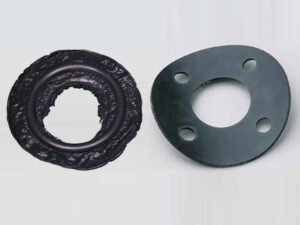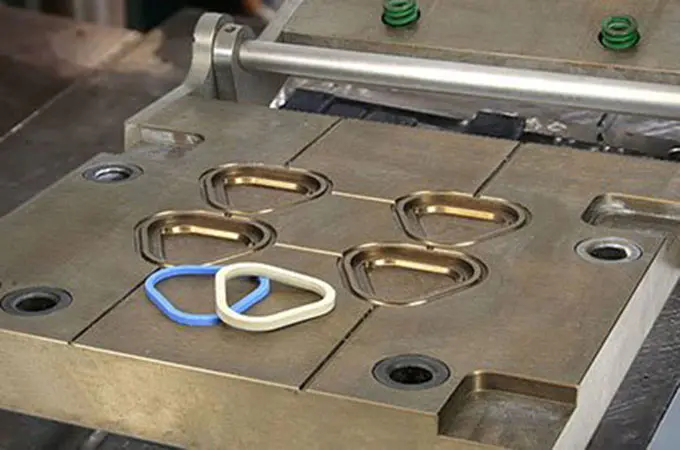Have you ever wondered what the most common compression molding defects are and how they might impact your project? Compression moulding is widely used across industries to produce high-quality and complex products. Rubber parts play a key role in reducing noise, vibration, and harshness in high-performance machines that drive global operations.
However, regardless of the product being manufactured, defects can occasionally occur. No process involving numerous variables and complex calculations is entirely foolproof, and these challenges can affect the final product’s quality and integrity. By working with the experienced manufacturers at Zhongde Rubber Parts, you can significantly reduce the risk of serious defects.
What are the common defects in rubber compression molding? This article focuses on compression moulding using widely used combination moulds and discusses common quality issues and their solutions.
What is the Rubber Compression Molding Process?
Molding methods for silicone products include rubber injection molding and rubber compression molding. The rubber compression molding process begin with filling the rubber compound into the cavity of a metal mold and vulcanizing it into a silicone product. However, due to the residual air and vulcanization gas in the cavity, the structure of the mold must be able to eliminate the residual gas through the pressure formed by the flow of rubber. The rubber must flow and contact the mold that has been heated to the curing temperature. Therefore, the rubber must maintain proper fluidity. The side of the cavity should not hinder the flow of the rubber material, and the product after vulcanization should have good mold release.
Common Compression Moulding Defects

Poor Surface State
The surface state is the rubber molding processing state of the mold surface, and the scorching of the rubber compound mostly causes the poor surface state. The scorch of the rubber compound is also affected by the change in parking conditions and time. It is often caused when the rubber compound flows in a high-temperature mold. At this time, the surface roughness in a wrinkled state can be seen. In addition, different smooth circular bright spots are also produced on the surface of the product. It can be considered that this is due to the release agent, which often occurs in the use of compounding agents that generate more gas and highly filled rubber compounds. The release agent should be evenly coated, and the molded product after vulcanization should be quickly released from the mold.
Lack of Glue
Collapse occurs on the surface of the compression-molded product. This is bec:use the mold is not exhausted and the amount of rubber filling is insufficient. The exhaust uses the elasticity of the rubber and the expansion force of the gas, so it loses the low viscosity effect that can make the rubber adhere to the surface of the model. On the other hand, the filling amount of the rubber in the cavity is insufficient, so the fluidity of the rubber is not fully utilized, resulting in the loss of the rubber to the outside of the cavity. As a countermeasure to solve this problem, the application of the release agent should be uniform and the speed of pressing the rubber should be slowed down.
The surface Is Finely Uneven
The reason for the fine collapse in rubber compression molding is considered to be due to poor dispersion of the melt compounding agent at the vulcanization temperature. The rubber material should be filtered or thinned to remove poorly dispersed additives. At this time, it should also be noted that the viscosity of the rubber compound will decrease and the vulcanization characteristics will also change. In addition, the generation of tiny pores is caused by the mixing of dissimilar materials and foreign substances into the rubber compound during the mixing operation. Others, such as the moisture absorption of the filler or the excessive cooling of the processing machinery during the mixing operation, will cause the product to have pores after vulcanization. In this case, the mold is easily contaminated, and the scorch of the rubber compound is promoted due to the matching, which affects the electrical insulation and thermal aging of the rubber compound. Therefore, the rubber compound cannot be used. The remaining bubbles in the rubber are often formed by air mixing during the calendering, and they can be eliminated by promoting the flow or exhaust of the rubber in the model; on the contrary, when the rubber fluidity is weak, it will produce defects such as flow marks. , If this is the case, large bubbles can be punctured.
Flow Marks
Flow marks in the rubber molding process are traces of rubber flow left on the surface of the product, in different states such as line and crack. The reason is that there is a problem with the flow of the rubber. The different viscosity caused by the difference in the heating state, the partial scorching of the rubber, and the contamination of the model surface will all cause obstacles to the rubber flow. During the custom compression molding process, the rubber material enters the mold, contacts the surface of the mold, and is heated, and a temperature gradient is generated on the surface and the inside of the rubber material, which causes the rubber material to flow unevenly in the cavity. The measures to be taken are to preheat the rubber material before entering the mold keep the rubber material in a low-pressure flow state during molding, and exhaust in a short period of time. At the same time, the molding pressure must always remain the same. For other reasons, there are substances deposited on the surface of the rubber compound, and the powder applied to prevent adhesion will affect it. The rubber is stored for a long time and is easy to cause blooming, so it is necessary to set a safe use period for the rubber after mixing. Also, excessive use of coating powder and release agents are both causes of flow marks.
Poor Fusion
Due to the pins and core plugs in the cavity, in the rubber compression molding process, the flow of the rubber material is cut off and then resumes the flow. The traces produced at this confluence are called weld lines or weld marks. The strength of the confluence part is low, which can easily become the starting point of failure. The reason is that air, materials that lack compatibility, and materials such as mold release agents accumulate here, and the surface of the product becomes blurred in the initial stage of continuous production, and then gradually dirt is generated on the mold surface. Clean the mold as soon as possible. In addition, the fast-vulcanized rubber will scorch the flowing surface. Therefore, attention should be paid to the thermal history of the performing process (calendering, extrusion) and the parking time of the rubber. With the increase in the parking time of the same batch of rubber, the defective rate of the rubber will gradually increase. As a way to solve this problem, the coating amount of the release agent should be small, or the sintered release agent should be used. For the residual air, while considering the flow direction of the rubber compound, attention should be paid to timely exhaust. When scorching occurs, it is necessary to shorten the thermal history during operation, and at the same time, wait for the rubber compound to cool before stacking.
Mold Shrinkage
The so-called mold shrinkage is irregularly shaped dents at the joints of large thick-walled products and cylindrical products, which is also called mold cracking. This is a common problem in compression molded parts. The inner surface of cylindrical products may also have scars. There is a difference between the vulcanization rate of the surface layer rubber and the inner rubber that contacts the mold. As the internal temperature of the rubber slowly rises, the internal pressure rises due to thermal expansion, causing the vulcanization of the surface layer to be squeezed into the clamping surface, and this part of the vulcanized rubber is damaged at the corners of the mold.
If it is a cylindrical product, the same phenomenon will occur due to the low core temperature and thermal expansion caused by the temperature rise during the vulcanization process. For the above reasons, consider making the temperature of the rubber contacting the mold surface the same as the temperature of the internal rubber, or vulcanizing the rubber surface and the inside in approximately the same state, first heating the rubber, and then injecting it into the cavity, This is difficult to do in injection molding, and the solution in compression moulding is not perfect, this is the status quo. One way to solve this problem is to round the burr corners of the mold and install a heat source on the core to keep it warm. During molding, the rubber material is heated to a scorching temperature, and the surface of the cavity is cooled with cold water to form a temperature gradient. This is a very effective measure.
How to avoid compression molding defects and solutions?
To address common compression moulding defects, manufacturers should focus on several key technical solutions. First, advanced mould design techniques, such as proper venting and optimized parting lines, can effectively reduce flash and ensure uniform material flow. Precision machining of the mould components improves dimensional tolerances and surface finish. Strict control of processing parameters—including mould temperature uniformity, accurate pressure application, and optimal curing times—minimizes internal stresses and voids. Furthermore, selecting appropriate compound formulations tailored to the product’s geometry and application helps mitigate shrinkage and warpage. Comprehensive in-process monitoring and post-moulding inspections, such as dimensional checks and non-destructive testing (NDT), are critical for ensuring consistent product quality.
Choosing the Right Rubber Compression Molding Manufacturer
Zhongde’s rubber compression molding, silicone compression molding, and plastic compression molding use quality raw materials directly from China. During the compression moulding process, Our resistant compression molding silicone rubber and compression molding plastic can be processed for many custom products applied in various industries. compression moulding products including compression molded rubber parts are stricted in the principle of compression molding processing standards.




